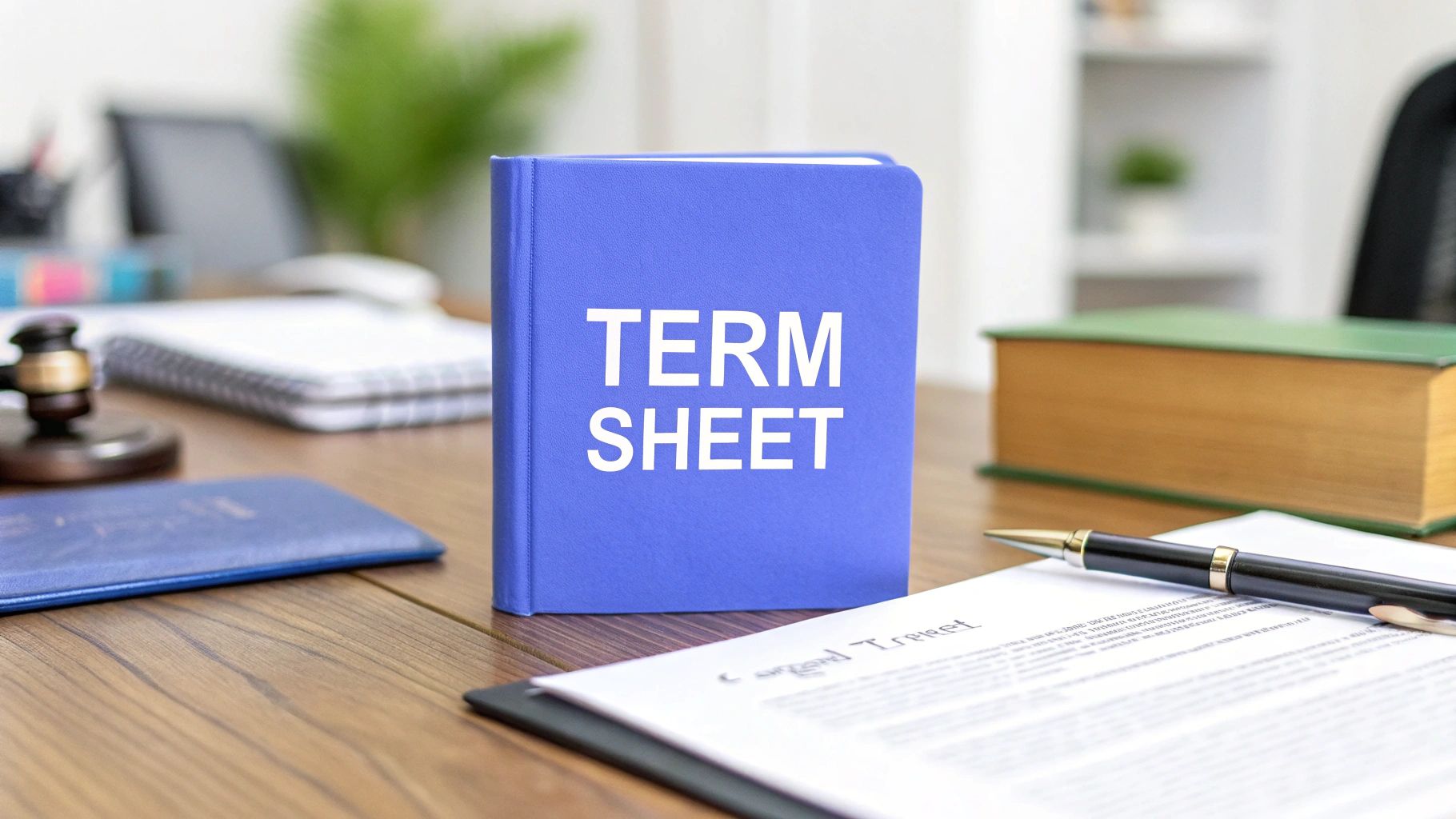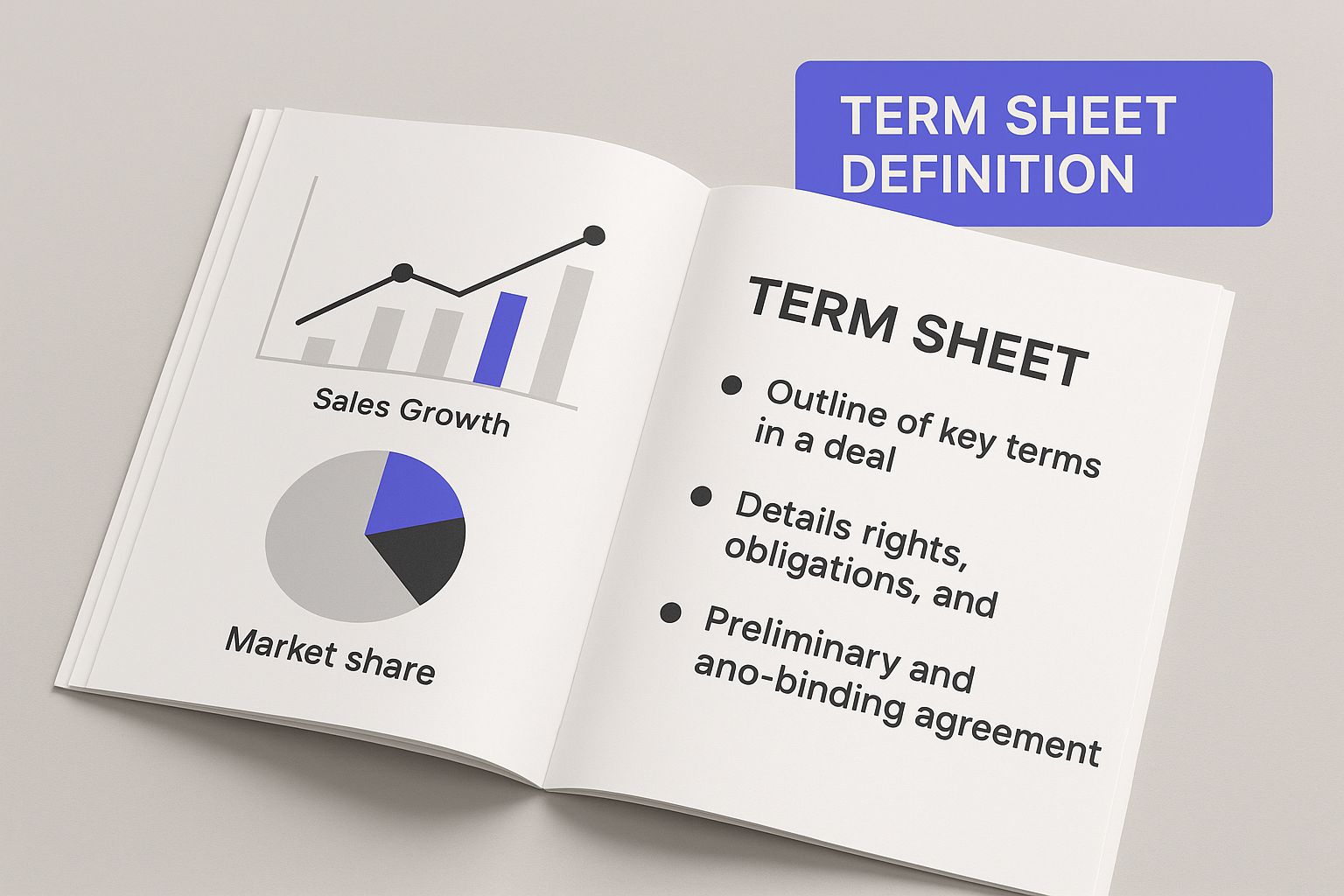
Think of a term sheet as the architectural blueprint for a major business deal. It's not the final, legally binding contract, but it's the foundational outline that ensures everyone involved is on the same page about the big-picture items like valuation, control, and investment amounts right from the start. Getting this down on paper first saves a ton of time, money, and headaches down the road.
What Is a Term Sheet and Why Does It Matter?
Have you ever tried to build something complex—say, a piece of furniture—without the instructions? It’s a recipe for chaos, frustration, and a wobbly end product. That's what negotiating a major business deal without a term sheet feels like, whether it's a venture capital investment, a merger, or a significant partnership.
A term sheet is that crucial first step. It’s a preliminary, mostly non-binding document that sketches out the core terms and conditions of a deal. It allows everyone to agree on the most important points before diving into the expensive and time-consuming process of drafting formal legal agreements.

As this visual shows, a term sheet is the organized, preliminary document that sits at the heart of business and financial negotiations, bringing structure to the conversation.
The "Handshake Agreement" on Paper
While it's often called a "good faith" agreement, a term sheet is much more structured than a simple conversation. It takes all those verbal negotiations and translates them into a clear, organized format that covers the deal-breakers and most critical components.
This usually includes things like:
- Valuation: What the company is worth before the new investment comes in.
- Investment Amount: The exact amount of cash the investors are putting on the table.
- Equity Stake: The percentage of the company the investors get for their money.
- Control Rights: Key details like who gets a seat on the board and what decisions require investor approval.
By getting these pillars of the deal in writing, both founders and investors can be sure they’re seeing eye-to-eye. If you want to dive deeper into these kinds of provisions, check out our guide on legal terms explained.
A signed term sheet signals serious intent. It creates powerful momentum and a moral obligation to proceed, even if most clauses aren't legally enforceable.
Binding vs. Non-Binding Clauses
It’s a huge misconception that term sheets carry no legal weight at all. While the main economic terms (like valuation and investment amount) are typically non-binding, a few key clauses are absolutely legally enforceable. These are designed to protect the integrity of the negotiation process itself.
Here’s a quick breakdown of what’s usually binding versus what’s not.
Term Sheet at a Glance: Binding vs. Non-Binding Elements
| Component | Description | Legal Status |
|---|---|---|
| Valuation, Price per Share | The company's agreed-upon value and the price investors pay for equity. | Non-Binding |
| Investment Amount | The total capital being invested into the company. | Non-Binding |
| Liquidation Preference | How proceeds are distributed to investors if the company is sold or liquidated. | Non-Binding |
| Board Composition | The structure of the board of directors, including investor seats. | Non-Binding |
| Confidentiality Clause | An agreement to keep all negotiation details and shared information private. | Binding |
| Exclusivity ("No-Shop") | A promise that the company won't negotiate with other potential investors for a set time. | Binding |
Typically, the two clauses you can count on being legally binding are:
- Confidentiality: This stops either side from blabbing about the sensitive financial and operational details shared during the talks.
- Exclusivity (or a "No-Shop" Clause): This gives the investor a set period (often 30-60 days) to conduct their due diligence without worrying about the company shopping the deal to other investors.
This dual nature is the term sheet’s secret sauce. It offers the flexibility to hash out the big-ticket items while providing a secure, protected space to get the deal done.
Decoding the Economics of a Venture Capital Deal
Beyond the handshake and the initial excitement, the economics of a venture capital deal are where the real work begins. This is where the future of your company is forged. A term sheet is much more than just a piece of paper; its financial mechanics determine not only how much money you get but how that cash translates into ownership and returns for everyone at the table.

At its core, the economic equation always comes down to valuation. The pre-money valuation is what investors agree your company is worth before their money comes in. Once the check clears, you have the post-money valuation.
Pre-Money Valuation + Investment Amount = Post-Money Valuation
This simple formula is the bedrock for figuring out who owns what. For example, if an investor puts $2 million into a company with an $8 million pre-money valuation, the post-money valuation becomes $10 million. The investor’s $2 million now buys them 20% of that new, larger pie, cementing their equity stake.
Protecting the Investment
Investors are taking a big risk, and they use specific clauses in the term sheet to protect their capital. These protective measures can dramatically alter a founder's financial outcome down the road, especially if the company is sold or liquidated.
One of the most important clauses here is the liquidation preference. Think of it as the investors getting their money back first, before anyone else sees a dime. It usually comes in two flavors:
- Non-Participating Preference: This is the more founder-friendly version. Investors get a choice: either take their original investment back (their $2 million, for instance) OR convert their preferred shares to common stock and share the sale proceeds with everyone else. They can't do both.
- Participating Preference: This is a form of "double-dipping." First, investors get their initial investment back. Then, they also get to share in the leftover proceeds on a pro-rata basis with other shareholders. This can seriously shrink the payout for founders and employees.
These preferences often come with a multiple, like a 1x or 2x preference, meaning the investor gets one or two times their investment back before other shareholders are paid. Just understanding this one term can save founders a world of hurt.
Guarding Against Future Dilution
Another key economic term is the anti-dilution provision. This protects investors if the company has to raise a future funding round at a lower valuation than what they paid—a dreaded "down round." This clause adjusts the investors' conversion price, effectively giving them more shares to shield their ownership percentage from being unfairly watered down.
The two most common types are:
- Full Ratchet: This one is pretty harsh for founders. It reprices all of the early investor’s shares to the new, lower price of the down round.
- Broad-Based Weighted Average: This is the market standard and much more balanced. It adjusts the price using a formula that accounts for the amount of new money raised and the new share price, leading to a far less punishing impact on the founders' equity.
While the term sheet itself is just the starting point, its real power lies in these economic clauses. They are the gears that drive a startup’s financial engine, influencing every future fundraising round and, ultimately, what success looks like for everyone involved.
Navigating Governance and Control Rights
Beyond the money, a term sheet fundamentally redefines who’s in the driver's seat. While the economic terms tell you how the pie gets sliced, the governance and control rights determine who gets to make the big calls. These clauses are the true blueprint for the new balance of power between you and your investors.

The most immediate change is usually at the board level. A term sheet will almost always specify the board composition, spelling out how many seats belong to the founders, the investors, and any independent members. An investor taking a board seat isn't just a formality; it gives them a direct vote on your company's strategic direction.
The Power of Protective Provisions
While a board seat gives an investor influence, protective provisions give them real veto power. In my experience, these are some of the most heavily negotiated clauses in any term sheet. They ensure that even if an investor is a minority shareholder, the company can’t make certain major decisions without their explicit green light.
Think of these provisions as an investor's safety net. They stop founders from unilaterally making game-changing moves that could jeopardize the investment. The list of what's covered is always up for debate, but it typically includes things like:
- Selling or merging the company.
- Issuing new shares that would dilute the investor's ownership.
- Taking on a significant amount of debt.
- Changing the size or composition of the board.
- Declaring bankruptcy or selling off major assets.
Getting these right is a delicate dance. As a founder, you want to keep as much operational freedom as possible. Your investors, on the other hand, need to shield their capital from huge risks. The goal is to find a middle ground that lets you run the business effectively while giving investors reasonable oversight on the big stuff.
Giving away too much control through overly restrictive protective provisions can paralyze a startup. Founders should carefully model how these veto rights might impact their ability to pivot or seize new opportunities quickly.
Rights to Information and Alignment
Finally, a couple of other common clauses shape how information flows and how everyone stays aligned. Information rights are a contractual obligation for the company to provide investors with regular financial statements and updates. This moves beyond simple trust, ensuring investors have the data they need to track the health of their investment.
On the flip side, drag-along rights are all about ensuring a smooth exit. This clause essentially forces minority shareholders (including founders and employees) to participate in a sale of the company if a majority of shareholders approve it. It might sound harsh, but it prevents a small group of holdouts from blocking a great acquisition that benefits everyone else. These governance terms, central to any term sheet definition, are what truly transform an investment into a partnership.
How Term Sheets Work in Mergers and Acquisitions
When a term sheet enters the world of mergers and acquisitions (M&A), the game completely changes. While the basic goal is still to outline a deal, the stakes are astronomically higher. We're no longer just talking about funding a company's growth—we're talking about buying or selling it outright.
In this high-stakes environment, the term sheet becomes a critical roadmap. It’s the first line of defense for managing immense risk and financial detail before anyone signs a binding purchase agreement.
The term sheet as we know it today really took off in Silicon Valley during the 1970s and 80s. Before it became standard practice, dealmakers had to jump straight into negotiating long, dense contracts. If talks fell apart, the time and money lost were staggering. The term sheet brought a much-needed framework to reduce that uncertainty, a benefit that's now essential in M&A deals where valuations can easily run into the billions. If you want to dive deeper into how these documents are used today, you can find out more about M&A term sheet practices.
Structuring the Purchase Price
One of the first, and arguably most important, sections in an M&A term sheet nails down the purchase price structure. This isn't as simple as the cash-for-equity swap you see in many venture deals. M&A transactions can be structured in a few different ways:
- All-Cash Deal: The buyer pays for the entire company with cash. It's clean, straightforward, and gives sellers immediate certainty.
- Stock-for-Stock Deal: The buyer uses its own stock as currency to acquire the target company. The sellers effectively trade their ownership for shares in the acquiring company.
- Hybrid Deal: A mix of cash and stock. This structure often strikes a balance, giving the seller some immediate cash while also offering potential upside if the buyer's company performs well.
The term sheet will also get into the nitty-gritty with things like working capital adjustments. This is a mechanism to make sure the buyer gets a business with a normal, healthy level of operating cash. If the actual working capital on the closing date is lower than an agreed-upon target, the purchase price gets reduced to compensate.
You might also see an earn-out provision. This is where sellers can get additional payments down the road if the business hits specific performance goals after the acquisition.
An earn-out can be a great way to bridge a valuation gap when a buyer is skeptical and a seller is optimistic. But be warned: they are notoriously complex and can easily lead to disputes after the deal closes if the milestones aren't crystal clear.
Allocating Risk and Future Liabilities
Another huge piece of the M&A puzzle is how the deal is legally structured. This decision has massive tax and liability implications for everyone involved, so it's a cornerstone of the term sheet. The two main paths are an asset sale and a stock sale.
In an asset sale, the buyer picks and chooses specific assets (and sometimes liabilities) to purchase. In a stock sale, the buyer acquires all the company's shares and inherits everything—the good, the bad, and the unknown liabilities lurking under the surface.
To manage all this risk, the term sheet will introduce representations and warranties. These are essentially statements of fact made by the seller about the health of the business. If those statements turn out to be false, the indemnification clauses kick in. Think of this as the seller's promise to cover the buyer's losses.
These clauses often include a basket (a deductible the buyer has to cover before making a claim) and a cap (the maximum amount the seller is on the hook for). How these terms are defined is paramount, as they determine who holds the risk long after the ink on the final agreement is dry.
Practical Strategies for Term Sheet Negotiation
Alright, so you’ve got a term sheet on the table. This is where the abstract concept of a deal meets the real world. It’s a test of strategy, foresight, and relationship-building. Think of it less like a battle to be won and more like laying the first bricks for a long-term partnership. Success here starts long before you ever sit down to talk specifics.
Your first move is to do your homework. Before a single conversation happens, you need a firm grasp on the current market standards for a company at your stage and in your industry. What are typical valuation ranges right now? What kind of liquidation preferences are investors asking for? Walking into the discussion armed with this data is your best defense against accepting unusual terms that could hamstring your company down the road.
Define Your Line in the Sand
Next, you need to figure out your non-negotiables. While you should be ready to give and take on most points, there will always be a few terms that are absolutely critical to your company's future—and your own role in it. Maybe it’s maintaining control of the board, steering clear of participating liquidation preferences, or ensuring the employee option pool is calculated on a post-money basis.
Knowing your absolute limits gives you a solid anchor during the back-and-forth. It lets you be flexible on less critical points while holding firm on what truly matters for your long-term vision.
The real goal of a negotiation isn't to squeeze every last drop out of the deal. It's to land on a fair agreement that aligns everyone's incentives and kicks off a healthy, productive relationship with your new partners.
This is where an experienced startup lawyer becomes your most valuable player. They don’t just redline documents; they're a strategic partner who has seen dozens of these deals play out. They can provide priceless context on what’s standard, what’s aggressive, and where you have room to push back. Think of their fee as a critical investment in your company’s future. For more on this, check out our guide on how to negotiate contracts, which dives into principles that apply here, too.
Creating Leverage and Building Relationships
Leverage is your best friend in any negotiation. Nothing creates leverage quite like having multiple term sheets from different investors. When VCs know they’re competing, it naturally pushes the terms in your favor and gives you the power to choose the best partner, not just the best deal on paper.
Finally, never forget that you are interviewing them just as much as they are interviewing you. Ask them the tough questions. Dig into how they get involved with their portfolio companies, how they handle disagreements, and what their track record really looks like. A term sheet negotiation isn’t just a transaction; it’s the first step of a multi-year journey you’ll be taking together. The best possible start is a fair deal reached through a respectful and transparent negotiation.
The Journey from Term Sheet to a Closed Deal
Signing a term sheet can feel like you’ve crossed the finish line. In reality, you've just heard the starting gun for the most intense leg of the race. This moment kicks off what's called the exclusivity period, a "no-shop" window where you agree to stop talking to other potential investors. This typically lasts anywhere from 30 to 90 days.
So, what happens during this time? One word: due diligence. Think of it as the investor’s home inspection for your company. They'll bring in their own team of legal and financial experts to lift the hood and make sure everything you’ve told them is accurate. They’ll pour over your financial statements, inspect key contracts, verify your intellectual property, and check that your corporate records are squeaky clean.
From Blueprint to Binding Agreements
As long as no major red flags pop up during due diligence, the next phase is turning the non-binding term sheet into fully binding legal documents. This is where the deal gets real, and abstract terms become concrete legal promises. All those key points you negotiated—valuation, liquidation preferences, board seats—are now drafted into what are called the definitive agreements.
These legally enforceable contracts usually include:
- Stock Purchase Agreement: The main contract that details the sale of company shares to the new investors.
- Voting Agreement: This lays out how shareholders, including both founders and investors, will vote on critical decisions, like electing board members.
- Investors’ Rights Agreement: This agreement outlines special investor rights, like getting regular financial updates or the right to invest in future funding rounds (pro-rata rights).
Managing this stage well is absolutely critical. Staying organized and having a solid grasp of your obligations can make this process much faster. Our guide on small business contract management offers practical advice to keep this phase moving smoothly and on track.
The transition from term sheet to definitive agreements is where a good lawyer earns their keep. They ensure the spirit of the deal is accurately captured in the letter of the law, protecting you from subtle but significant changes in language.
The whole journey wraps up at the closing. This is the official event where everyone signs the final agreements, and the investor wires the money to your company’s bank account. What started as a handshake deal is now a fully executed partnership. And don't underestimate the power of a solid term sheet; data shows that in M&A, a well-defined one can slash negotiation time by about 25%, paving a much smoother road to closing. You can discover more insights about how term sheets streamline deal execution.
A Few Common Questions About Term Sheets
Once you start digging into the details of a business deal, a lot of questions pop up. It's completely normal. Let’s walk through some of the most common ones that founders and investors ask about term sheets, so you can feel more confident during your negotiations.
Is a Term Sheet Legally Binding?
For the most part, no. The big-ticket items—like valuation and how much money is on the table—aren't legally enforceable. Think of them as a good-faith handshake that sets the direction for the deal, giving everyone some wiggle room to negotiate.
However, a couple of clauses are almost always binding, and for good reason:
- Confidentiality: This is a legally binding promise. It stops either side from sharing any details about the deal or the sensitive information you've exchanged.
- Exclusivity (or "No-Shop"): This clause legally prevents the company from shopping the deal around to other investors for a specific period, usually 30 to 90 days.
These binding parts are there to protect the integrity of the negotiation itself.
How Long Does a Deal Take After a Term Sheet?
This can vary, but for a standard venture capital deal, you should probably plan on it taking somewhere between 30 and 90 days to get from a signed term sheet to a closed deal.
This gives the investors time to do their homework—what’s called due diligence—and allows the lawyers to draft the final, fully binding legal agreements.
A term sheet is the starting point, the roadmap for the deal. But it's not set in stone. What comes out during due diligence can absolutely change the final terms.
Can Terms Change After Signing?
Yes, they absolutely can. The term sheet is just the beginning of the conversation. If the investors’ due diligence uncovers something unexpected—maybe a financial issue or a legal risk—they have every right to renegotiate the important terms. They can even walk away from the deal entirely.
The term sheet gets the ball rolling, but it's the final, definitive agreements that lock everything in place.
Feeling like you're drowning in dense legal language? Legal Document Simplifier uses AI to translate complex contracts into clear, easy-to-understand summaries. Get the clarity you need to make confident decisions. Upload your document and see how simple it can be at https://legaldocumentsimplifier.com.